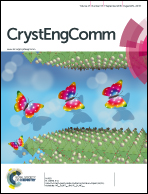Pillared-bilayer zinc(ii)–organic laminae: pore modification and selective gas adsorption†
Abstract
Three porous metal–organic frameworks, namely {[Zn2(azpy)(aip)2]·2DMF}n (1, azpy = 4,4′-azobipyridine, H2aip = 5-aminoisophthalic acid), {[Zn2(dipytz)(aip)2]·1.15DMF·0.85MeOH}n (2, dipytz = di-3,6-(4-pyridyl)-1,2,4,5-tetrazine) and {[Zn2(tpim)(aip)2]·2.5DMF·2H2O}n (3, tpim = 2,4,5-tri(4-pyridyl)imidazole), were synthesized under mild conditions. All of the compounds consisted of a honeycomb-like layer, [Zn(aip)]n, further pillared by N-donor ligands to form two-dimensional (2D) porous pillared-bilayer frameworks with 1D channels created inside the bilayers (4.1 × 10.1 Å2 for 1, 4.1 × 11.1 Å2 for 2, and 5.1 × 9.8 Å2 for 3). The resulting MOFs showed different pore volumes and channel shapes depending on the length and shape of the pillar ligands (35.7%, 41.7%, and 33.9% for 1–3, respectively). The pore volume in 3 decreased due to the presence of the uncoordinated pyridyl group of the tpim ligand. The frameworks of 1 and 2 show flexible properties upon undergoing solvent-exchange processes and their CO2 adsorption properties are different. These latter properties are affected by the functional groups of the linear pillar ligand (–N![[double bond, length as m-dash]](https://www.rsc.org/images/entities/char_e001.gif) N– and tetrazine group). In particular, compound 3 possesses less flexibility upon undergoing a solvent-exchange process and preferentially absorbs CO2 more efficiently rather than H2 and N2.
N– and tetrazine group). In particular, compound 3 possesses less flexibility upon undergoing a solvent-exchange process and preferentially absorbs CO2 more efficiently rather than H2 and N2.


 Please wait while we load your content...
Please wait while we load your content...